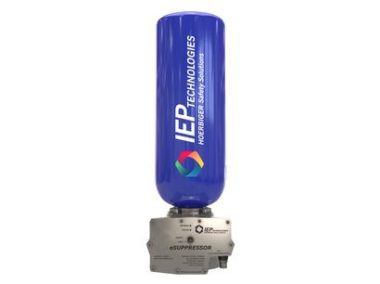eSUPPRESSOR – IEP Technologies
Suppresseur d'explosion à décharge rapide
breadcrumb >> list
High-Rate Discharge Suppressor
The IEP Technologies eSUPPRESSOR™ is a high-rate discharge suppressor used for explosion suppression and isolation systems. Its electro-mechanical operation is unique to the industry, as no pyrotechnic devices are required for activation. The eSUPPRESSOR has standard features that include pressure monitoring, lock outtag out capability and LED indication of device status. A key benefit is that all the safety functions are fully monitored, which is not possible for any device employing pyrotechnic actuators. The eSUPPRESSOR design and manufacture has SIL2 third party certification. Upon detection of an explosion event, the Explosion Protection Control Unit sends an actuation signal to the eSUPPRESSOR valve mechanism. The highly specified trigger mechanism allows the valve flap to open extremely rapidly (less than 10ms), which allows the suppressant to be discharged through the nozzle system into the protected volume.
Caractéristiques
- Unsurpassed reliability due to continuous monitoring of all safety functions
- Electromechanical actuation
- Monitored Lock-Out-Tag-Out (LOTO)
- Cylinder pressure monitoring with temperature compensation
- Non-explosive operation increases safety, and reduces storage, licensing, and transportation concerns
- Third party certification to SIL-2
- Can be mounted on existing IEP flanges to potentially replace all members of IEP’s existing family of suppressors
- Integrated LEDs to indicate suppressor status
- Valve housing: IP67, NEMA 4x
- Rated for dust and gas hazardous locations
- Transportation licenses: TPED and UN-DOT
Use in Vessels or Ductwork
The IEP Technologies eSUPPRESSOR is designed to discharge suppressant in milliseconds within a process vessel or to mitigate the propagation of flame through interconnected ductwork. It is used in conjunction with IEP Technologies’ range of control panels and detectors. IEP Technologies’ sophisticated computer modelling techniques determine the expected reduced explosion pressure (Pred) and the quantity and size of suppressors to be employed.
